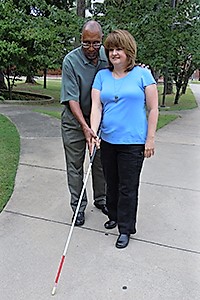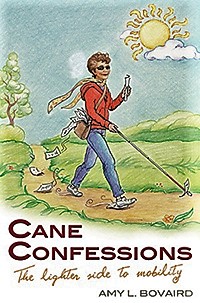Orientation and Mobility: Tips for Getting Around when Blind or Low Vision
This content is also available in:
Español (Spanish)
 Learning to use the white
Learning to use the white
cane with an O&M instructor
Orientation and Mobility (O&M) is a profession specific to blindness and low vision that teaches safe, efficient, and effective travel skills to people of all ages:
- “Orientation” refers to knowing where you are and where you want to go, whether you’re moving from one room to another or walking downtown for a shopping trip.
- “Mobility” refers to the ability to move safely, efficiently, and effectively from one place to another, such as walking without tripping or falling, crossing streets, and using public transportation.
Orientation and Mobility Specialists
An Orientation and Mobility (O&M) Specialist provides instruction to help you develop or re-learn the skills and concepts needed to travel safely and independently within your home and the community. O&M Specialists provide services across the lifespan, teaching infants and children in pre-school and school programs and adults in various community-based and rehabilitation settings.
The Academy for Certification of Vision Rehabilitation and Education Professionals (ACVREP) offers certification for vision rehabilitation professionals, including O&M Specialists. A Certified Orientation and Mobility Specialist (COMS) must adhere to a professional Code of Ethics and demonstrate knowledge and teaching skills in the following areas:
- Sensory development, or maximizing all of your senses to help you know where you are and where you want to go
- Using your senses in combination with self-protective techniques and human guide techniques to move safely through indoor and outdoor environments
- Using a cane and other devices to walk safely and efficiently
- Soliciting and/or declining assistance
- Finding destinations with strategies that include following directions and using landmarks and compass directions
- Techniques for crossing streets, such as analyzing and identifying intersections and traffic patterns
- Problem-solving skills to determine what to do if you are disoriented or lost or need to change your route
- Using public transportation and transit systems.
Amy Bovaird, Author of Mobility Matters: Stepping Out in Faith and Cane Confessions: The Lighter Side to Mobility

Amy Bovaird is a VisionAware Peer Advisor and author of Mobility Matters: Stepping Out in Faith and Cane Confessions: The Lighter Side to Mobility, her compelling memoirs that recount her life as an international teacher and traveler, her diagnosis of retinitis pigmentosa, and her triumph at learning to travel independently once again, using her long white cane.
Says Amy, “Mobility matters. It allows me to join the rest of society, follow my interests and passions, and reconnect with my love for traveling. I don’t have to stay at home fearing the dark anymore. I can live independently.”Learn more about ways to find emotional support for you – and your family members – after an eye condition diagnosis:
O & M Instruction
O&M instruction is usually conducted on a one-to-one basis. It can take place either in the community where you live and/or work (called “itinerant O&M”) or at a rehabilitation center (called “center-based O&M”).
To locate an Orientation and Mobility Specialist in your home area, our Directory of Services includes information about Orientation and Mobility instruction.
Transcript of Video
NARRATOR 1: A man using a cane climbs steps at a shopping center.
NARRATOR 2: For those experiencing vision loss, the world may seem like one big locked door. It can be frustrating getting around both in and out of the house. Working with a trained orientation and mobility specialist can be the key to reentering the world. These trained professionals teach independent travel skills which are always geared towards a person’s individual needs. There are techniques for working with or being a sighted guide, walking with a cane, methods to taking advantage of public transportation and self-protective techniques when entering a new environment. Walking through a doorway, for example, can present hazards not experienced by those who are sighted. Notice how this man with low vision holds his arm out away from his body like a shield, while a person who uses a cane has a very different, but equally safe, approach.
NARRATOR 1: A man wearing a cowboy hat crosses the street while using a cane.
NARRATOR 2: Here’s an example of someone listening to the direction of traffic before he crosses the street.
NARRATOR 1: Another man approaches a busy crosswalk.
NARRATOR 2: Orientation and mobility specialists also teach people how to use sound cues and their remaining vision to travel around safely and efficiently.
NARRATOR 1: The man presses the button for the traffic signal.
NARRATOR 2: And there are other methods, too, including using an audible traffic signal. Receiving professional training can lead you back to the road of independence.